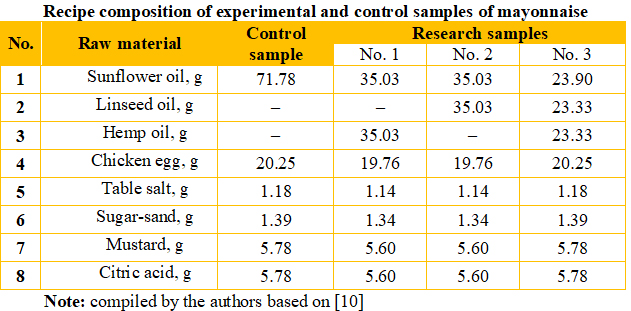Developing a strategy for improving mayonnaise with different proportions of vegetable oils
DOI:
https://doi.org/10.15587/2706-5448.2023.286488Keywords:
mayonnaise, polyunsaturated fatty acids, linseed oil, hemp oil, SWOT analysis, product launch strategyAbstract
The object of research is the process of forming a strategy for the improvement of mayonnaise. Based on the SWOT analysis, a strategy for improving mayonnaise with a different ratio of sunflower, linseed and hemp oils was formed in order to increase the content of polyunsaturated fatty acids, in particular the Omega-3 family, reduce its calorie content, and develop a strategy for bringing the product to the market.
During the research, the following methods were used: economic-statistical, SWOT analysis method, expert method, analytical, program-targeted, as well as statistical methods of experimental data processing.
The work solves the task of forming a strategy for improving the recipe composition of industrially produced mayonnaise and bringing it to the market. Today, the market offers a huge number of mayonnaises with different compositions and different quality, with low, medium and high fat content, with the addition of various additives that are undesirable for the human body. Based on the broad possibilities of using mayonnaise as an additional food product, the task arose to make changes in its composition, improving the biological and nutritional value of mayonnaise with an increased content of polyunsaturated fatty acids, in particular of the Omega-3 family. Such a modified food product can be considered functional because, on the one hand, polyunsaturated fatty acids (PUFAs) of the Omega-3 family are in short supply in the diet of the average Ukrainian, and on the other hand, they play an important role in the prevention of diseases of the cardiovascular, nervous, and immune systems of the body. The conducted analysis of economic, social and technological factors characterizing the products offered on the mayonnaise market made it possible to formulate a strategy for improving mayonnaise with different proportions of sunflower, linseed and hemp oils, as well as bringing it to the market using marketing tools.
The practical implementation of these proposals will make it possible to bring mayonnaise with reduced calorie content to the market, which will contain a significantly higher content of PUFAs of the Omega-3, Omega-6 and Omega-9 family, which are useful for the human body. Therefore, the use of linseed and hemp oils is recommended for supporters of healthy food, which makes it popular among the main groups of consumers.
References
- Helikh, A., Prymenko, V., Vasylenko, O., Prikhodko, I. (2021). The Study of Quality and Safety Indicators of Mayonnaise on the Basis of Hemp Oil. Restaurant and Hotel Consulting. Innovations, 4 (2), 345–360. doi: https://doi.org/10.31866/2616-7468.4.2.2021.249104
- DSTU 4487:2005. Maionezy. (2006). Kyiv: Derzhspozhyvstandart Ukrainy, 16.
- Sova, N., Lutsenko, M., Lobanova, A., Hrekova, N. (2019). Use of hemp oil in mayonnaise technology. Bulletin of the National Technical University «KhPI» Series: New Solutions in Modern Technologies, 5 (1330), 152–159. doi: https://doi.org/10.20998/2413-4295.2019.05.20
- Gogus, U., Smith, C. (2010). n-3 Omega fatty acids: a review of current knowledge. International Journal of Food Science & Technology, 45 (3), 417–436. doi: https://doi.org/10.1111/j.1365-2621.2009.02151.x
- Goyal, A., Sharma, V., Upadhyay, N., Gill, S., Sihag, M. (2014). Flax and flaxseed oil: an ancient medicine & modern functional food. Journal of Food Science and Technology, 51 (9), 1633–1653. doi: https://doi.org/10.1007/s13197-013-1247-9
- Smoliar, V. I. (2006). Kontseptsiia idealnoho zhyrovoho kharchuvannia. Problemy kharchuvannia, 4, 14–24.
- Chen, D. K., Metherel, A. H., Rezaei, K., Parzanini, C., Chen, C. T., Ramsden, C. E. et al. (2023). Analysis of omega-3 and omega-6 polyunsaturated fatty acid metabolism by compound-specific isotope analysis in humans. Journal of Lipid Research, 100424. doi: https://doi.org/10.1016/j.jlr.2023.100424
- Shubravska, O. V., Sokolska, T. V. (2013). Rozvytok rynku maionezu: svitovi tendentsii i vitchyzniani perspektyvy. Ekonomika i prohnozuvannia, 2, 80–93.
- Lewinska, A., Zebrowski, J., Duda, M., Gorka, A., Wnuk, M. (2015). Fatty Acid Profile and Biological Activities of Linseed and Rapeseed Oils. Molecules, 20 (12), 22872–22880. doi: https://doi.org/10.3390/molecules201219887
- Kryskova, L. P., Pokotylo, O. S. (2023). Fatty acid composition of mayonnaise based on sunflower, flax and hemp oil. Scientific Messenger of LNU of Veterinary Medicine and Biotechnologies, 25 (99), 99–103. doi: https://doi.org/10.32718/nvlvet-f9917
- Blanco-Gutiérrez, I., Varela-Ortega, C., Manners, R. (2020). Evaluating Animal-Based Foods and Plant-Based Alternatives Using Multi-Criteria and SWOT Analyses. International Journal of Environmental Research and Public Health, 17 (21), 7969. doi: https://doi.org/10.3390/ijerph17217969

Downloads
Published
How to Cite
Issue
Section
License
Copyright (c) 2023 Larysa Kryskova, Serhii Spivak

This work is licensed under a Creative Commons Attribution 4.0 International License.
The consolidation and conditions for the transfer of copyright (identification of authorship) is carried out in the License Agreement. In particular, the authors reserve the right to the authorship of their manuscript and transfer the first publication of this work to the journal under the terms of the Creative Commons CC BY license. At the same time, they have the right to conclude on their own additional agreements concerning the non-exclusive distribution of the work in the form in which it was published by this journal, but provided that the link to the first publication of the article in this journal is preserved.







